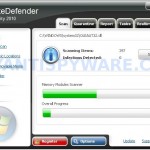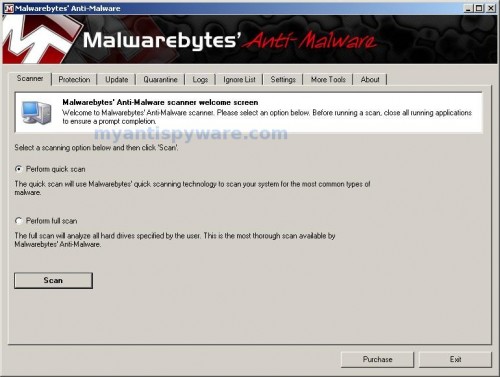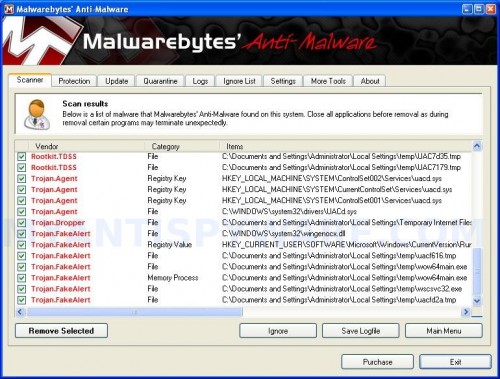 ByteDefender or ByteDefender Security 2010 is a fresh rogue antispyware program from the WiniGuard family of malware as SystemArmor, SecurePcAv, etc. This application classified as rogue antispyware program because it usually installed through the use of trojans and uses false scan results and fake security alerts as method to scare you into thinking that your computer is infected as an attempt to trick you into purchasing the software.
ByteDefender or ByteDefender Security 2010 is a fresh rogue antispyware program from the WiniGuard family of malware as SystemArmor, SecurePcAv, etc. This application classified as rogue antispyware program because it usually installed through the use of trojans and uses false scan results and fake security alerts as method to scare you into thinking that your computer is infected as an attempt to trick you into purchasing the software.
Once installed, ByteDefender will register itself in the Windows registry to run automatically when Windows starts. Immediately after launch, ByteDefender will begin to scan your computer and report that your computer is infected with numerous infections that will not be fixed unless you first purchase it. It is important to know that all of these infections are fake, so you can safely ignore the scan result.
While ByteDefender is running your computer will show nag screens, fake security alerts and notifications from Windows task bar that stats that your computer is infected by spyware or being attacked by an Internet Virus. However, all of these alerts are a fake and like scan false results should be ignored!
If your computer is infected with ByteDefender, then use these removal instructions below, which will remove ByteDefender and any other infections you may have on your computer for free.
Symptoms in a HijackThis Log
O4 – HKLM\..\Run: [ByteDefender] “C:\Program Files\ByteDefender Software\ByteDefender\ByteDefender.exe” -min
Use the following instructions to remove ByteDefender (Uninstall instructions)
Download MalwareBytes Anti-malware (MBAM). Once downloaded, close all programs and windows on your computer.
Double-click on the icon on your desktop named mbam-setup.exe. This will start the installation of MalwareBytes Anti-malware onto your computer. When the installation begins, keep following the prompts in order to continue with the installation process. Do not make any changes to default settings and when the program has finished installing, make sure a checkmark is placed next to “Update Malwarebytes’ Anti-Malware” and Launch “Malwarebytes’ Anti-Malware”. Then click Finish.
MalwareBytes Anti-malware will now automatically start and you will see a message stating that you should update the program before performing a scan. If an update is found, it will download and install the latest version.
As MalwareBytes Anti-malware will automatically update itself after the install, you can press the OK button to close that box and you will now be at the main menu. You will see window similar to the one below.

Malwarebytes Anti-Malware Window
Make sure the “Perform quick scan” option is selected and then click on the Scan button to start scanning your computer for ByteDefender infection. This procedure can take some time, so please be patient.
When the scan is finished a message box will appear that it has completed scanning successfully. Click OK. Now click “Show Results”. You will see a list of infected items similar as shown below.
Note: list of infected items may be different than what is shown in the image below.

Malwarebytes Anti-malware, list of infected items
Make sure all entries have a checkmark at their far left and click “Remove Selected” button to remove ByteDefender. MalwareBytes Anti-malware will now remove all of associated ByteDefender files and registry keys and add them to the programs’ quarantine. When MalwareBytes Anti-malware has finished removing the infection, a log will open in Notepad and you may be prompted to Restart.
Note 1: if you can not download, install, run or update Malwarebytes Anti-malware, then follow the steps: Malwarebytes won`t install, run or update – How to fix it.
Note 2: if you need help with the instructions, then post your questions in our Spyware Removal forum.
Note 3: your current antispyware and antivirus software let the infection through ? Then you may want to consider purchasing the FULL version of MalwareBytes Anti-malware to protect your computer in the future.
ByteDefender creates the following files and folders
%UserProfile%\Desktop\ByteDefender.lnk
C:\Documents and Settings\All Users\Start Menu\Programs\ByteDefender.lnk
C:\Program Files\ByteDefender Software
C:\Program Files\ByteDefender Software\ByteDefender
C:\Program Files\ByteDefender Software\ByteDefender\ByteDefender.exe
C:\Program Files\ByteDefender Software\ByteDefender\Uninstall.exe
ByteDefender creates the following registry keys and values
HKEY_CURRENT_USER\Software\ByteDefender
HKEY_LOCAL_MACHINE\SOFTWARE\ByteDefender
HKEY_LOCAL_MACHINE\SOFTWARE\Microsoft\Windows\CurrentVersion\Uninstall\ByteDefender
HKEY_LOCAL_MACHINE\SOFTWARE\Microsoft\Windows\CurrentVersion\Run\ByteDefender











